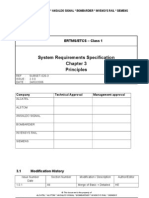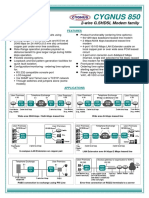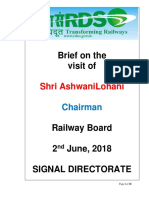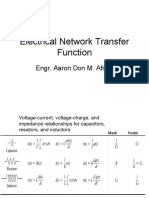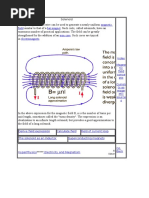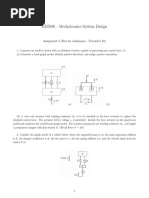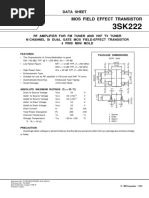Artc SMP 24
Artc SMP 24
Uploaded by
A.K.SINGHCopyright:
Available Formats
Artc SMP 24
Artc SMP 24
Uploaded by
A.K.SINGHOriginal Title
Copyright
Available Formats
Share this document
Did you find this document useful?
Is this content inappropriate?
Copyright:
Available Formats
Artc SMP 24
Artc SMP 24
Uploaded by
A.K.SINGHCopyright:
Available Formats
Discipline
Engineering Standard –NSW
Category
Signalling
Title
Vital Signalling Relays
Reference Number
SMP 24 –(RIC Standard: SC 00 52 00 24 SI)
Document Control
Status Date Prepared Reviewed Endorsed Approved
GM
Standards and Standards Infrastructure Safety
Systems Engineer Strategy & Committee
Issue 1
Mar 05 Performance
Revision 2
Refer to Refer to minutes
Reference H Olsen M Owens of meeting
Number 12/08/04
Engineering Standard –NSW
Signalling SMP 24
Vital Signalling Relays
Disclaimer
Australian Rail Track Corporation has used its best endeavors to ensure that the content,
layout and text of this document is accurate, complete and suitable for its stated purpose.
It makes no warranties, express or implied, that compliance with the contents of this
document shall be sufficient to ensure safe systems of work or operation. Australian Rail
Track Corporation will not be liable to pay compensation in respect of the content or
subsequent use of this document for any other purpose than its stated purpose or for any
purpose other than that for which it was prepared except where it can be shown to have
acted in bad faith or there has been willful default.
Document Approval
The technical content of this document has been approved by the relevant ARTC
engineering authority and has also been endorsed by the ARTC Safety Committee.
Document Supply and Control
The Primary Version of this document is the electronic version that is available and
accessible on the Australian Rail Track Corporation Internet and Intranet website.
Iti
sthedocumentuser ’ssol er esponsi bility to ensure that copies are checked for currency
against the Primary Version prior to its use.
Copyright
The information in this document is Copyright protected. Apart from the reproduction
without alteration of this document for personal use, non-profit purposes or for any fair
dealing as permitted under the Copyright Act 1968, no part of this document may be
reproduced, altered, stored or transmitted by any person without the prior written consent
of ARTC.
March 2005 Version 1.2 © Australian Rail Track Corporation Page 2 of 18
This document is uncontrolled when printed.
Engineering Standard –NSW
Signalling SMP 24
Vital Signalling Relays
About This Standard
This Standard defines the procedures to be followed when it is necessary to
carry out the maintenance requirements for vital signalling relays.
March 2005 Version 1.2 © Australian Rail Track Corporation Page 3 of 18
This document is uncontrolled when printed.
Engineering Standard –NSW
Signalling SMP 24
Vital Signalling Relays
Document History
Primary Source –RIC Standard SC 00 52 00 24 SI Version 2.0
List of Amendments –
ISSUE DATE CLAUSE DESCRIPTION
1.1 01/09/2004 Reformatting to ARTC Standard
1.2 14/03/2005 Disclaimer Minor editorial change
March 2005 Version 1.2 © Australian Rail Track Corporation Page 4 of 18
This document is uncontrolled when printed.
Engineering Standard –NSW
Signalling SMP 24
Vital Signalling Relays
Contents
1 GENERAL ..................................................................................................................6
1.1 SEALING OF RELAYS ............................................................................................................................. 6
1.2 CYCLIC CHANGING AND OVERHAUL OF RELAYS ......................................................................... 6
1.2.1 General Policy ...............................................................................................6
1.2.2 Jeumont Schneider Track relays ...................................................................7
1.3 TYPE OF WIRE CONNECTING TO SHELF RELAYS ........................................................................... 7
2 PLACING SIGNALLING RELAYS INTO SERVICE ( REFERALSO TO “ SMP 11 -
RELAYCHANGE” )........................................................................................................8
2.1 GENERAL ................................................................................................................................................... 8
2.2 SHELF TYPE RELAY - RECORDING RELAY CHANGE INFORMATION ....................................... 10
3 MINIATURE PLUG-IN RELAYS BRB SERIES: CARE OF/HANDLING ..................10
4 LARGE SIZE (STANDARD `B' TYPE) PLUG-IN-RELAYS: DISTORTED CONTACT
CARRIER ....................................................................................................................10
5 PRECAUTIONS TO BE TAKEN WHEN CHANGING MAGNETICALLY LATCHED
RELAYS ......................................................................................................................11
5.1 ROUTE NLR AND RLR RELAYS ..................................................................................................... 11
5.2 POINT NLR AND RLR RELAYS ........................................................................................................ 11
5.3 RELEASE SWITCH NLR OR RLR RELAYS .................................................................................. 12
6 ROUTINE EXAMINATIONS AND TESTS ................................................................12
6.1 EXAMINATION OF AC RELAYS, VANE ALL TYPES ...................................................................... 12
6.2 EXAMINATION OF DC RELAYS, SHELF -MOUNTED .................................................................... 13
6.3 EXAMINATION OF PLUG-IN RELAYS ............................................................................................... 14
6.4 TESTING OF TIME LIMIT RELAYS .................................................................................................... 14
6.5 EXAMINATION OF SUSPECT RELAYS, ALL TYPES ...................................................................... 14
7 DESPATCH, TRANSPORT AND HANDLING OF RELAYS ....................................14
8 RE-USE OF Q TYPE RELAYS ................................................................................15
8.1 VISUAL INSPECTION ............................................................................................................................ 15
8.2 OPERATING TESTS .............................................................................................................................. 15
8.3 CONTACT FULL CURRENT CLEANING ........................................................................................... 16
8.4 RELAYS WITH MORE THAN TEN YEARS USE ............................................................................... 16
8.5 RELAYS IN SERVICE ............................................................................................................................ 16
8.6 ALTERATIONS REQUIRING SPARE CONTACTS TO BE BROUGHT INTO SERVICE ................. 16
9 FORMS .....................................................................................................................17
March 2005 Version 1.2 © Australian Rail Track Corporation Page 5 of 18
This document is uncontrolled when printed.
Engineering Standard –NSW
Signalling SMP 24
Vital Signalling Relays
1 GENERAL
The Signal Engineer shall ensure there is an up to date program for the changing and overhaul of
relays as required by the policy.
As the proper working of all relays is essential, the following instructions shall be most carefully
observed and where signalling maintainers are in doubt with regard to the condition of any relay
they shall report it to the Signal Maintenance Engineer immediately.
1.1 Sealing of Relays
All vital relays supplied by manufacturers and workshops are sealed, and all relays installed in
the field that are not presently sealed, shall be considered as sealed and not opened.
This seal shall not be broken in the field except in exceptional circumstances when directed by a
Signal Engineer. In the event of a defect being observed in a relay the seal shall be left intact
until the relay is examined by a Signal Engineer.
1.2 Cyclic Changing and Overhaul of Relays
1.2.1 General Policy
The policy for changing and overhauling all shelf mounted relays and AC vane type plug-in
relays is based on two (2) main classifications of relays, "Proved" and "Unproved".
Unproved shelf relays shall be changed after 15 years in service and overhauled in the
workshops or scrapped.
Relays which are proved to release (down proved in circuit) are not to be changed on a regular
basis but on an as required basis as determined by the normal inspections by the signal
electricians.
Shelf or AC vane plug-in type track relays used for cut tracks are to be changed on a 10 year
basis.
In the case of all plug-in relays, except AC vane type, a regular overhaul period is not laid
down.
Samples of plug-in relays, other than AC vane type, from typical installations are to be
inspected in detail after 20 years in service to assess the need for overhaul or replacement of
the complete group, or to assess the period to the next sample inspection.
This inspection shall be carried out in the Signal Workshops, Rail Equipment Centre, and shall
be arranged by the signal electrician in conjunction with the Signal Engineer who shall advise the
Manager, Signal Workshops (Rail Equipment Centre). The sample relays are to be completely
dismantled during the inspection.
The Workshop Manager shall obtain a report from the workshops and forward a copy to the
ARTC General Manager ISP or nominated Signalling representative. After the inspection
report is accepted by Engineering Design the sample relays which were dismantled for
inspection may be discarded.
March 2005 Version 1.2 © Australian Rail Track Corporation Page 6 of 18
This document is uncontrolled when printed.
Engineering Standard –NSW
Signalling SMP 24
Vital Signalling Relays
When shelf type relays are required to be changed they shall be replaced by a shelf mounted
plug-in relay conversion unit. eg:-
BRB miniature 50v
BRB miniature 12v dc
BRB miniature dc track (QT2, QTMI on cut tracks)
The policy to be progressively implemented is to discontinue the practice of workshop
servicing of shelf type line relays and shelf type dc track relays.
Shelf mounted Signal Branch type dc relays shall not be used.
If in service they are to be immediately replaced, preferably with a shelf mounted plug-in relay
conversion unit and where this is not practical by a DN 11 type shelf relay.
1.2.2 Jeumont Schneider Track relays.
This type of relay is to be kept under review until a fault or deterioration rate requires their
replacement.
1.3 Type of wire connecting to shelf relays
When a shelf relay is fitted with a detachable top, flexible stranded wire (eg 9/0.3mm) may be
terminated on the detachable top using appropriate insulated crimp lugs. Ensure that bakelite
terminal covers are fitted and the lugs on different terminals do not cross one another.
When a shelf relay is not fitted with a detachable top, flexible stranded wire must not be
terminated directly onto the relay.
Single strand, stiff wire (eg 1/1.7mm) without crimp lugs is to be used on these relays. Where
thisisr equiredt or untoa“ Q”t yperel
ayors imi larwhichwi llnota cceptt hiswi re,an
interfacing terminal block shall be used.
In cases where flexible, stranded wire has already been terminated directly onto shelf relays the
following is required:-
Ensure that crimp lugs do not touch one another or other terminals.
Whenever it is necessary to change the relay or to disconnect then reconnect
the wiring for any reason,
a) each wire must be labelled with its relay terminal number and
b) each crimp lug must be insulated as it is removed from the relay with
either suitable sized plastic tubing which will fit tightly over the crimp
lug or with another equally secure product.
March 2005 Version 1.2 © Australian Rail Track Corporation Page 7 of 18
This document is uncontrolled when printed.
Engineering Standard –NSW
Signalling SMP 24
Vital Signalling Relays
2 PLACING SIGNALLING RELAYS INTO SERVICE
(
Ref
eral
sot
o“SMP 11 - Rel
aychange”
)
2.1 General
The integrity of all vital signalling relays to be placed into service is paramount particularly as
they may be installed in circuits where they are not proved to release when de-energised.
Signalling relays must be handled, transported and stored with care and not in any manner,
condition or circumstance that would subject them to damage or deterioration.
The relays must be stored on racks in enclosed buildings in a clean, dry and non-corrosive
environment. They must always be kept in the upright position in case of any undetected
foreign matter which has fallen to the bottom of the case moves to a critical position.
Spare overhauled relays with workshop testing dates in excess of that specified below shall not
be placed into service and shall be resubmitted to the Signal Maintenance Engineer for retesting.
Plug In D.C Relays Seven (7) Years
Plug In A.C Relays Three (3) Years
D.C Shelf Relays Five (5) Years
A.C Shelf Relays Three (3) Years
Ne w“ Q”Ty pepl ug-in relays which have been stored in their original boxes or packaging for
periods up to seven (7) years may be used without being overhauled provided that the relay
passes the visual examination specified in Clause 8.1 and the operating tests specified in Clause
8.2.
Relays which do not pass the inspection and/or test should be forwarded to the Signal
Maintenance Engineer as described in Clause 8.1 & 8.2.
Prior to placing any plug-in relay in service it shall be closely inspected to see that the contacts
are aligned correctly and that it has not been damaged in transit. When plug-in relays are to be
changed, before insertion into the plug-in base, the signalling maintainer shall ensure that the
replacement relay is the same voltage, the same contact arrangement (by direct examination of the
contacts) and that the code pins are present in the same indexing locations. The base shall be
fitted with one set only of five index holes. The signalling maintainer shall check the contacts to
ensure they are not high resistance. Where relay test panels are provided this facility is to be
utilised. The signalling maintainer shall check the operation of the relay in circuit and ensure that
the functions controlled by it operate correctly.
Immediately prior to any relay being placed in service it must be examined at a bench under
full lighting conditions by the signal maintainer who is to install the relay. The signalling
maintainer shall also arrange a test circuit to check the relay under operation.
March 2005 Version 1.2 © Australian Rail Track Corporation Page 8 of 18
This document is uncontrolled when printed.
Engineering Standard –NSW
Signalling SMP 24
Vital Signalling Relays
The signalling maintainer is to examine the relay under normal electrical operation, observing
the energise/de-energise cycle several times to ensure that the mechanical operation is normal,
unrestricted but not pounding, and that the relay drops fully away.
Where there is any cause to suspect that the relay is not operating correctly it shall be
immediately labelled accordingly and sent to the Signal Maintenance Engineer for more
detailed testing together with written advice of the problem.
Once the relay has been installed it shall be observed to function fully in its operating circuit
and shall not be certified until the signalling maintainer is satisfied that it is operating
correctly.
The ARTC GM ISP or nominated Signalling representative shall be promptly advised of all
incidents of an unsafe condition whether in use or in storage of a vital signalling relay and
shall nominate a signal engineer from the design section and, as required, a person from the
Signal Workshops, Rail Equipment Centre, to examine the relay before it is unsealed.
Before placing a shelf-mounted relay in service special care shall be taken to remove the
armature securing screw provided to prevent damage during transport. The arrangement of
terminals vary for different manufacturers of shelf-mounted relays, it is therefore necessary
that signalling maintainers take special care when replacing a relay by one of a different
manufacture to see that the connections are placed on the correct relative terminals and that
circuit diagrams are updated for any change in contact numbers. The relay shall be examined
and bench tested by the signalling maintainer prior to installation.
Also before placing the shelf-mounted relay in service the suitably accredited signalling
maintainer shall remove the nuts on the studs and check that the bottom nut is tightened down.
This is to ensure that the pigtail is securely maintained by a tight armature stud or that the
carbon pillar is securely maintained in position by a tight point stud. Excessive force shall not be
applied on the bottom nut as this could cause the stud to fracture.
When a shelf-mounted relay has been replaced the signalling maintainer changing the relay is
responsible for seeing that a thorough test and check is made of all circuits passing through the
relay to ensure that no incorrect connections have been made and that the circuits are in
accordance with the circuit diagrams.
In addition when any dc shelf-mounted relay or dc plug-in track relay or dc standard 'B' size
plug-in relay is changed the "pick-up", "drop-away" and "working" currents of the new relay
shall be tested.
SF J135/B "Relay Changed Forms", at present, shall be made out in duplicate by the signalling
maintainer for all shelf relays replaced and these forms shall be forwarded to the Signal
Maintenance Engineer immediately after the relay or relays have been changed. The signalling
maintainer shall show all relevant particulars on these forms and certify that the circuits through
the shelf-mounted relays have been tested and are correct.
March 2005 Version 1.2 © Australian Rail Track Corporation Page 9 of 18
This document is uncontrolled when printed.
Engineering Standard –NSW
Signalling SMP 24
Vital Signalling Relays
2.2 Shelf type relay - Recording relay change information
In the event of a shelf type relay being tested, installed or removed from service the signalling
maintainer shall fill out the relay changed form SF.J135/B Rev.1 form and forward it to Signal
Maintenance Engineer for recording.
When a relay has been replaced, newly installed or removed permanently from service the local
relay records or database is to be bought up to date to reflect the change. Details of newly
installed or replaced relays including the install date are to be included.
3 MINIATURE PLUG-IN RELAYS BRB SERIES: CARE
OF/HANDLING
Cases have occurred where newly installed miniature plug-in signalling relays have failed to
operate, and it was found that their contacts were out of adjustment due to distortion of their
stationary contact support brackets.
It has been demonstrated that this fault was a result of the relay having been dropped or struck
during transport or installation.
Extreme care shall be exercised in transporting and handling relays. Any relay which is
bumped or dropped should be closely examined and tested, and if need be sent to the
workshops for overhaul.
Because of the risk that relays may have been dropped or damaged without knowledge, any
relay which is to be placed in service shall be visually inspected, then inserted in a relay test
unit and observed to operate correctly before being plugged into service.
If there is any sign of damage to the case or to the relay or if the operation or the relay is in any
way suspect if shall not be put into service but sent for overhaul.
4 LARGE SIZE (STANDARD `B' TYPE) PLUG-IN-RELAYS:
DISTORTED CONTACT CARRIER
Special note should be taken, by all signalling maintainers concerned with the handling and
placing into service of large size plug in relays, that contacts can become seriously out of
adjustment due to rough handling.
Before placing a relay into service it must be carefully examined to see that all contacts, both
front and back, make with sufficient over travel and open sufficiently (when applicable). If a
relay is suspect or in any way damaged it shall be sent to the Signal Maintenance Engineer for
inspection.
Large size plug-in relays are particularly prone to maladjustment of contacts due to the alloy
casting which carries the coil becoming misaligned at some angle other than 90 degrees
relative to the relay base. This is usually caused by the relay being dropped during transit or
installation.
When these relays are transported by any means they must be packed with the contact springs
vertical and "THIS SIDE UP" labels applied appropriately.
March 2005 Version 1.2 © Australian Rail Track Corporation Page 10 of 18
This document is uncontrolled when printed.
Engineering Standard –NSW
Signalling SMP 24
Vital Signalling Relays
5 PRECAUTIONS TO BE TAKEN WHEN CHANGING
MAGNETICALLY LATCHED RELAYS
Magnetically latched relays remain in the position to which they were last operated and for this
reason special precautions are required to ensure that a relay is "down" before it is plugged into
service. Magnetically latched relays are used for the parent relay of the route, point and release
lock relays and the procedure for changing these relays is as follows.
5.1 Route NLR and RLR Relays
Prior to unplugging a route NLR or RLR relay the signalling maintainer shall :
a) Ensure that the signal to which the route lock relay applies is at stop, the route
normalised, and that any train which is approaching the signal has been
brought to a stand.
b) The magnetically latched relay which is to be placed in service shall then be
plugged into the magnetically latched relay test base and the indicator lamp
observed to ensure that the relay is down.
The relay to be withdrawn from service is then unplugged and the new relay removed from the
test base and plugged into service.
Note: After changing a route NLR relay both the route NLR and RLR may be
down. This will be indicated by a steady white light in the button knob
controlling the route and the button shall be pulled to energise the NLR.
5.2 Point NLR and RLR relays
Prior to unplugging a point NLR or RLR relay the signalling maintainer shall:
a) Ensure that no trains are standing foul of or passing over or approaching the
points concerned.
b) Ensure that all signals which protect the points concerned are at stop and that
any trains which may be approaching those signals have been brought to a
stand.
c) The magnetically latched relay which is to be placed in service shall then be
plugged into the magnetically latched relay test base and the indicator lamp
observed to ensure that the relay is down.
d) The relay to be withdrawn from the service is then unplugged and the new
relay is removed from the test base and plugged into service.
Note: After changing a point lock relay both point NLR and RLR relays may be down.
This will be indicated by both point position lights extinguished, and the
transit light flashing. Under these conditions it will be necessary to move the
point lever to the centre position and then to return the lever to its previous
position and thereby energises the point lock relay for the
March 2005 Version 1.2 © Australian Rail Track Corporation Page 11 of 18
This document is uncontrolled when printed.
Engineering Standard –NSW
Signalling SMP 24
Vital Signalling Relays
position in which the points are laying.
5.3 Release Switch NLR or RLR Relays
Prior to unplugging a release NLR or RLR relay the signalling maintainer shall:
a) Ensure that no trains are standing foul of or passing over or approaching the
ground frame points concerned.
b) Ensure that all signals which protect the ground frame points are at stop and that
any trains which may be approaching those signals have been brought to a stand.
c) The magnetically latched relay which is to be replaced into service must then be
plugged into the magnetically latched relay test base and the indicator lamp
observed to ensure that the relay is down.
d) The relay to be withdrawn from service is then unplugged and the new relay is
removed from the test base and plugged into service.
6 ROUTINE EXAMINATIONS AND TESTS
6.1 Examination of AC Relays, Vane all types.
Vane and polyphase AC relays, including contacts, pigtails and terminals, shall be inspected
periodically for any signs of abnormal conditions.
Examine all non-proved vane AC relays every 52 weeks and whenever the opportunity
presents.
Particular attention shall be paid to the working of the vane and for any indication of the
following conditions, by observation through the glass case.
The relay shall be observed to operate correctly.
Check for abnormal release operation of a relay, eg sluggish, jerky or not falling fully to the
stop position may be due to defective bearings, warped bakelite tops, wax or other foreign
matter in the bearings, vane obstructions, etc.
Check that there is no foreign matter or flaking plating or paint inside the relay.
Check for deposits of wax, varnish or paint on the vane which may indicate overheating of
coils or contact with pole faces.
Check for scratches or abrasions on the vane which may indicate that the vane is distorted or
that air gap tolerances are incorrect.
Check if the bottom of the vane could be spread due to striking the bottom of the relay case.
This condition can first be detected by a mark in the paint of the case bottom. A vane allowed
to spread could become jammed between the pole faces.
March 2005 Version 1.2 © Australian Rail Track Corporation Page 12 of 18
This document is uncontrolled when printed.
Engineering Standard –NSW
Signalling SMP 24
Vital Signalling Relays
Check that the vane is central between and clear of pole faces. Vane distortion may be evident
from observing the relay in operation.
Check the surface of the vane spindle for any accumulation of dust or discolouration which
may be attributed to wear of the bearings.
Do not place in service A.C. vane shelf relays fitted with black coils without coil formers, as
some these are suspected of releasing wax from the coils when hot.
If other types of relays in service exhibit evidence of wax deposits then details are to be
reported.
Examine all non-proved AC vane shelf relays with black coils without coil formers for the
presence of wax coatings and, where noted, check the release operation of the relay. Also
examine the contacts for any noticeable presence of wax contamination.
Immediately change out non-proved A.C. vane shelf relays with black coils without coil
formers and with evidence of wax and program those without evidence of wax for priority
changout, and have the Signal Maintenance Engineer scrap this type of relay after removal
from service.
Keep on record in the section depot a separate list of each and every non-proved relay circuit
function on the section which is fitted with an A.C. vane shelf relay. This list would include
track relays, track indicating relays, signal N1 relays, release switch normal relays, detector
relays etc., etc.,
If correct operation of a relay is in doubt advise the Signal Maintenance Engineer and change out
the relay immediately and label it accordingly. The Signal Maintenance Engineer is to
promptly examined the relay as follows.
Check that ends of split pins are properly spread.
Check that the counter weight lock nut is locking the counter weight and that they have not
moved.
Examine roller stops for evidence of grooving.
Examine spring type stops for evidence of grooving and ensure that the spring is effective and is
not fouled by its bracket when the relay is energised and that they are tight and there is no sign
of cracking.
6.2 Examination of DC Relays, Shelf-Mounted
Signalling maintainers are responsible for the inspection of all dc shelf-mounted relays on their
section. These relays shall be inspected every 52 weeks and whenever the opportunity presents
for any unusual condition and to see that the armature is operating freely and drops away
promptly when the relay is de-energised. If any sluggishness or failure of the armature to drop
away promptly is observed, the relay shall be replaced immediately and the Signal Maintenance
Engineer advised. When making this check due allowance should be made for a slow release
relay.
March 2005 Version 1.2 © Australian Rail Track Corporation Page 13 of 18
This document is uncontrolled when printed.
Engineering Standard –NSW
Signalling SMP 24
Vital Signalling Relays
6.3 Examination of Plug-in Relays
Signalling maintainers shall examine, to the extent practical without removal, all plug-in
relays, both Standard `B' size and miniature, on their sections every 52 weeks and whenever
the opportunity presents. They shall particularly be on the look out for:
(a) any signs of the clear plastic in the covers fouling the contact assembly due to
warping or cracking.
(b) any signs of contact burning, or pitting of the carbon contacts, and any signs of
displaced carriers.
(c) any signs of rust on plated components or signs of excessive deterioration of the
plating.
Signalling maintainers shall replace relays if any of these or other defects are detected and
advise the Signal Maintenance Engineer.
6.4 Testing of Time Limit Relays
Electro-mechanical type and thermal type time limit relays shall be regularly tested at not more
than two years intervals to see that they operate at the specified timing and the necessary details
entered on a SF J135/C form and forwarded to the Signal Maintenance Engineer.
The relay shall be considered defective if the timing varies by more than ten percent of the
specified timing.
Defective relays shall be sent to the Signal Maintenance Engineer for attention.
ARTC type approved electronic time limit relays, such as QTD5 time limit relays are not required
to be tested.
6.5 Examination of Suspect Relays, all types
The Signal Engineer is to promptly arrange for a relay replaced because of doubtful operation
to be examined by a Signal Engineer delegated by the ARTC GM ISP or nominated Signalling
representative, and the Manager, Signal Workshops, Rail Equipment Centre.
7 DESPATCH, TRANSPORT AND HANDLING OF RELAYS
Relays removed or replaced shall be forwarded to the Signal Workshops (Rail Equipment
Centre) for overhaul or scrapping with a label detailing the reasons for its removal.
Relays should be handled and transported at all times with care and always be kept in the
upright position in case any foreign matter has escaped detection and can move into a critical
position to prevent proper operation.
March 2005 Version 1.2 © Australian Rail Track Corporation Page 14 of 18
This document is uncontrolled when printed.
Engineering Standard –NSW
Signalling SMP 24
Vital Signalling Relays
8 RE-USE OF Q TYPE RELAYS
Before Q Type (BRB930) miniature plug in relays, which have been in service for ten years or less,
are considered for reuse in new or altered works, the following procedure of inspection and
operating tests shall be carried out and the relay shall meet all performance criteria.
8.1 Visual Inspection
Visually examine the relay to ensure that:
a) Seals are intact
b) The cover and base (base of the relay itself) mouldings are not chipped, cracked or
warped.
c) Register pins are straight and correctly coded
d) Plug-in contact fingers are not bent, distorted or burnt and have not lost tension
e) There is no sign of overheating within the relay
f) There are no signs of the plastic cover fouling the contact assembly or the assembly
being misaligned.
g) Plated components are not corroded and are not showing signs of deterioration
h) There is no loose or foreign matter inside the cover
i) The cover is still transparent and there is no internal coating of a rust coloured,
metallic or greasy nature.
If the relay has any of the defects listed above or if the seals are broken, the relay is to be returned
to the workshops for scrapping or overhaul.
Relays which in all respects pass the visual test shall be operationally tested as follows.
8.2 Operating Tests
Place the relay into the miniature relay test set and check.
a) Pick up and drop away values (see Relays Manual)
b) Normal operation i.e. no chatter, excessive hum, slow to pick up or drop away
(except where this is a function of the particular relay).
c) Pick up and drop away times (where applicable).
If the relay fails a) or b) it shall be scrapped. If it fails c) it shall be returned to the
workshops for scrapping or overhaul.
d) Check the contact resistance of each contact pair in the relay.
March 2005 Version 1.2 © Australian Rail Track Corporation Page 15 of 18
This document is uncontrolled when printed.
Engineering Standard –NSW
Signalling SMP 24
Vital Signalling Relays
If the resistance is greater than 2 ohms the contact maybe able to be cleaned by cycle testing the
contact at its full rated current. Retest for resistance. If now less than 2 ohms the relay may be
re-used. If still more than 2 ohms the relay must be sent to the workshops for mechanical
cleaning and service.
Note: A relay with contact resistance readings up to 7.5 ohms may be re-used as a
temporary measure if no replacement is available. This relay must be
replaced without delay. Such relays shall be marked "High resistance
contacts,relaytober epla ced”.
8.3 Contact Full Current Cleaning
All relays which have had contacts full current cleaned MUST have a permanent label affixed
whi chs tates“Nos.......... contacts full current cleaned on .................. Signed ................... ”
.
8.4 Relays with more than Ten Years Use
Any Q type relay removed from service which has been in operational use for more than ten
years shall, provided it passes visual inspection, be returned to the workshops for overhaul.
8.5 Relays in Service
The above procedure for carrying out visual inspections and operating tests may also be used to
test and clean relay contacts which are in service or which have been removed from service with
suspected or proven high resistance contacts.
8.6 Alterations requiring spare contacts to be brought into service.
Whenever there are circuit alterations and circuits are connected to spare contacts that have not
been in use for some time there is a probability that the contact may be high resistance. Again
cycle testing the spare relay contact with its full rated current before it is connected in service
may reduce the contact resistance and should be carried out, as required.
March 2005 Version 1.2 © Australian Rail Track Corporation Page 16 of 18
This document is uncontrolled when printed.
Engineering Standard –NSW
Signalling SMP 24
Vital Signalling Relays
9 FORMS
Australian Rail Track Corporation Signalling Form SF J135/B Rev.1 RELAYS
CHANGED
DISPLACED RELAY NEW RELAY
No. TYPE MAKERS LOCATION CIRCUIT REPAIR DATE No. TYPE MAKERS PICK UP DROP AWAY WORKING WORKSHOP TESTS
NAME REQN. No. NAME CURRENT PICK UP DROP AWAY
I certify that all connections to the relays are correct as per circuit.
Name: Section:
Signature Date:
March 2005 Version 1.2 © Australian Rail Track Corporation Page 17 of 18
This document is uncontrolled when printed.
Engineering Standard –NSW
Signalling SMP 24
Vital Signalling Relays
Australian Rail Track Corporation
March 2005 Version 1.2 © Australian Rail Track Corporation Page 18 of 18
This document is uncontrolled when printed.
You might also like
- NCERT Grade 10 Physics Electricity FlashcardsDocument51 pagesNCERT Grade 10 Physics Electricity Flashcardsangelin2020aradhanaNo ratings yet
- 3.II BO23-User - Documentation-V6Document65 pages3.II BO23-User - Documentation-V6Ranjeet SinghNo ratings yet
- Glossary of Railway Terminology-RSSBDocument36 pagesGlossary of Railway Terminology-RSSBArseneNo ratings yet
- Aftac 2Document2 pagesAftac 2Daniel GheorgheNo ratings yet
- Delhi Metro Rail Corporation Training InstituteDocument43 pagesDelhi Metro Rail Corporation Training Instituteanil singh100% (1)
- Train Detection System Tdr14Document14 pagesTrain Detection System Tdr14abodd88No ratings yet
- Ex2-Shunt WoundDCGenerator - Ver3Document7 pagesEx2-Shunt WoundDCGenerator - Ver3John C. CarlsenNo ratings yet
- List of Irs Specs SignalDocument2 pagesList of Irs Specs SignalbhaskarjalanNo ratings yet
- Railway Fail-Safe Signalization and Interlocking Design Based On Automation Petri NetDocument5 pagesRailway Fail-Safe Signalization and Interlocking Design Based On Automation Petri NetmikeNo ratings yet
- AF-902 and AF-904Document99 pagesAF-902 and AF-904Lim Seok WooNo ratings yet
- RSE-1A1 Mlk2 Overview PDFDocument12 pagesRSE-1A1 Mlk2 Overview PDFAnonymous fE2l3Dzl100% (1)
- Balaji ADocument66 pagesBalaji ABalaji BaluNo ratings yet
- Rdso SPN 147-2005, UfsbiDocument29 pagesRdso SPN 147-2005, Ufsbima_purwoadiNo ratings yet
- Basic Concepts of Signalling: Indicators and MarkersDocument9 pagesBasic Concepts of Signalling: Indicators and MarkersPAUL DURAINo ratings yet
- 1 Appendix Functional Tests For SW-FAT Westrace MK2 - DocxDocument16 pages1 Appendix Functional Tests For SW-FAT Westrace MK2 - DocxRickyNo ratings yet
- 8 Back To Basics InterlockingDocument16 pages8 Back To Basics InterlockingSivaji KotipalliNo ratings yet
- GM 09 Axle Counter Presentation 1-13Document13 pagesGM 09 Axle Counter Presentation 1-13anujsharma77No ratings yet
- Handbook On Fuses & Their Applications in Railway SignallingDocument46 pagesHandbook On Fuses & Their Applications in Railway SignallingPrakharNo ratings yet
- Uniformity Report V1Document21 pagesUniformity Report V1VIPIN DOBHALNo ratings yet
- Relay and Electronic InterlockingDocument11 pagesRelay and Electronic InterlockingAkhlesh ChoureNo ratings yet
- 20101028-RBTC PresenrtationDocument18 pages20101028-RBTC Presenrtationkrisna_hrd7710No ratings yet
- Question BankDocument285 pagesQuestion BankBhavani Prasad BandaNo ratings yet
- IXL ESA 44 - en PDFDocument39 pagesIXL ESA 44 - en PDFcavcicNo ratings yet
- Microsoft Word - SSDAC 2DP1S-IM Version 1.0, Rev.4Document127 pagesMicrosoft Word - SSDAC 2DP1S-IM Version 1.0, Rev.4innocent ali50% (2)
- Sg0602002 Typical Signalling & Control Systems CircuitsDocument171 pagesSg0602002 Typical Signalling & Control Systems CircuitsJeremy Rifkin100% (1)
- Guidance On Lineside Signal Aspect and Indication RequirementsDocument83 pagesGuidance On Lineside Signal Aspect and Indication Requirementsle5100kw100% (1)
- Final Project Report2Document52 pagesFinal Project Report2SGVU UniversityNo ratings yet
- Frauscher - MsdacDocument90 pagesFrauscher - Msdacser.aman1992No ratings yet
- Signalling in RailwaysDocument314 pagesSignalling in RailwaysMeet BhattNo ratings yet
- FNmux Draft SpecificationDocument16 pagesFNmux Draft SpecificationNaresh KumarNo ratings yet
- Rdso Spec - For Msdac - 176/2013: (VERSION:3.0)Document10 pagesRdso Spec - For Msdac - 176/2013: (VERSION:3.0)Bhupen PaliNo ratings yet
- Signalling Relay Spec PDFDocument2 pagesSignalling Relay Spec PDFIndranilNo ratings yet
- Dependability of Railway Control & Communications Systems v2Document28 pagesDependability of Railway Control & Communications Systems v2Shashi Bhusan Singh100% (1)
- (H) Point Detection Relay (NWKR/RWKR) CircuitDocument39 pages(H) Point Detection Relay (NWKR/RWKR) CircuitNeeraj Kumar MathuriyaNo ratings yet
- S11Control Table & Selection Circuits PDFDocument66 pagesS11Control Table & Selection Circuits PDFvoru89No ratings yet
- Railway SignallingDocument9 pagesRailway Signallinglan_acuNo ratings yet
- Sliding Booms Policy WRDocument6 pagesSliding Booms Policy WRNaresh LalwaniNo ratings yet
- SUBSET-026-3 v230 - 060224Document101 pagesSUBSET-026-3 v230 - 060224David WoodhouseNo ratings yet
- S4 - Mechanical Signalling - Double Wire PDFDocument105 pagesS4 - Mechanical Signalling - Double Wire PDFPooja SinghNo ratings yet
- Cygnus 850: 2-Wire G.SHDSL Modem FamilyDocument2 pagesCygnus 850: 2-Wire G.SHDSL Modem FamilyPradeep Kumar YadavNo ratings yet
- 21620signalling PlansDocument16 pages21620signalling PlansVeera Babu AdapaNo ratings yet
- Vendor Approval Requirements For Transformers RDSODocument6 pagesVendor Approval Requirements For Transformers RDSORishik SainiNo ratings yet
- SUBSET-040 v2.3.0Document33 pagesSUBSET-040 v2.3.0zumzuru7394No ratings yet
- Handbook On Standardization of Infrastructural Facilities For Maintenance of ART ARME 140T CraneDocument12 pagesHandbook On Standardization of Infrastructural Facilities For Maintenance of ART ARME 140T CraneSaptarshi PalNo ratings yet
- Electronics ReportDocument43 pagesElectronics ReportRajat SinghNo ratings yet
- Datasheet 5E-5Document8 pagesDatasheet 5E-5mikeNo ratings yet
- CDC-Booklet On S&TDocument136 pagesCDC-Booklet On S&TAbhijitNo ratings yet
- Maintenance AzS350UDocument89 pagesMaintenance AzS350UAditya WicaksonoNo ratings yet
- Handbook On Electronic LC Gate Communication System (Wired & Wireless) in IRDocument54 pagesHandbook On Electronic LC Gate Communication System (Wired & Wireless) in IRjoel mshanaNo ratings yet
- Handbook On Signalling Symbols & Terminology PDFDocument35 pagesHandbook On Signalling Symbols & Terminology PDFUday KumarNo ratings yet
- Essentials of IXLDocument8 pagesEssentials of IXLJunaidNo ratings yet
- Vol.4 - 5 - Signalling - SIPDocument20 pagesVol.4 - 5 - Signalling - SIPMaulik RavalNo ratings yet
- Yazhini Project 1Document64 pagesYazhini Project 1yazhini yazhNo ratings yet
- Pre Commission Check List For 2DP1S-Ver1 PDFDocument21 pagesPre Commission Check List For 2DP1S-Ver1 PDFecarvind100% (1)
- 7 PDFDocument418 pages7 PDFRohit KumarNo ratings yet
- Test Specification For Eurobalise FFFIS-subset-085 PDFDocument341 pagesTest Specification For Eurobalise FFFIS-subset-085 PDFMickNo ratings yet
- Kavach: Cab Signalling & Automatic Train Protection System for Digital RailwaysFrom EverandKavach: Cab Signalling & Automatic Train Protection System for Digital RailwaysNo ratings yet
- Guard/Check Rails, Buffer Stops and DerailsDocument12 pagesGuard/Check Rails, Buffer Stops and DerailsEmilyNo ratings yet
- As 1755-1986 Conveyors-Design, Construction, Installation, and Operation-Safety RequirementsDocument14 pagesAs 1755-1986 Conveyors-Design, Construction, Installation, and Operation-Safety RequirementsallovidNo ratings yet
- Brief On The Visit Of: Shri AshwanilohaniDocument18 pagesBrief On The Visit Of: Shri AshwanilohaniA.K.SINGHNo ratings yet
- Final Handout 48 CBRR 17-08-2017Document102 pagesFinal Handout 48 CBRR 17-08-2017A.K.SINGHNo ratings yet
- ED - Hand OutDocument43 pagesED - Hand OutA.K.SINGHNo ratings yet
- CRB Handout 2019 Ver 2Document16 pagesCRB Handout 2019 Ver 2A.K.SINGHNo ratings yet
- Brief On The Visit Of: Shri AshwanilohaniDocument19 pagesBrief On The Visit Of: Shri AshwanilohaniA.K.SINGH100% (1)
- CRB Handout 09.10.18Document19 pagesCRB Handout 09.10.18A.K.SINGHNo ratings yet
- CRB Handout 02.11.18 - FinalDocument19 pagesCRB Handout 02.11.18 - FinalA.K.SINGHNo ratings yet
- Anubhut YogavaliDocument184 pagesAnubhut YogavaliA.K.SINGHNo ratings yet
- CBRR All Projects - SignalDocument5 pagesCBRR All Projects - SignalA.K.SINGHNo ratings yet
- Maintenance Handbook On Electric Lifting Barrier PDFDocument25 pagesMaintenance Handbook On Electric Lifting Barrier PDFA.K.SINGHNo ratings yet
- 34GCM-Com Software Protocol Ver1.2Document3 pages34GCM-Com Software Protocol Ver1.2A.K.SINGHNo ratings yet
- Tpws ProjectDocument35 pagesTpws ProjectA.K.SINGHNo ratings yet
- Handbook On Flow Charts For RRI Siemens PDFDocument21 pagesHandbook On Flow Charts For RRI Siemens PDFA.K.SINGH50% (2)
- UPSC Monthly Magazine May 1 15thDocument77 pagesUPSC Monthly Magazine May 1 15thA.K.SINGHNo ratings yet
- Leonics Inverter - SGP210 SeriesDocument0 pagesLeonics Inverter - SGP210 SerieskapishsharmaNo ratings yet
- MCP1702 Voltage RegulatorDocument26 pagesMCP1702 Voltage RegulatorathielsNo ratings yet
- Electrical Network Transfer FunctionDocument21 pagesElectrical Network Transfer FunctionRyan Arce100% (2)
- Electric Circuits 2 Lab1Document6 pagesElectric Circuits 2 Lab1Hesham Ben aliNo ratings yet
- New Microsoft Word DocumentDocument4 pagesNew Microsoft Word DocumentraviNo ratings yet
- Assignment 2Document3 pagesAssignment 2Sukanthan V ed20b066No ratings yet
- Introduction To Electricity - SCDocument35 pagesIntroduction To Electricity - SCRielle Dela MercedNo ratings yet
- 8 Position Dip SwitchDocument2 pages8 Position Dip SwitchChai SilwanusNo ratings yet
- 7A.Protest Software Presentation MACROS-2Document13 pages7A.Protest Software Presentation MACROS-2madhan_22No ratings yet
- Minicargador Plano ElectricoDocument27 pagesMinicargador Plano Electricocr266332No ratings yet
- Load CalculationDocument8 pagesLoad Calculationlastwarning100% (1)
- Basler GPS100 Relay ManualDocument446 pagesBasler GPS100 Relay ManualcsceeNo ratings yet
- Iot Based Intelligent Traffic Control System: International Journal of Engineering Technology Research & ManagementDocument5 pagesIot Based Intelligent Traffic Control System: International Journal of Engineering Technology Research & ManagementExam2 CSENo ratings yet
- General Physics 2: San Fabian National High SchoolDocument10 pagesGeneral Physics 2: San Fabian National High SchoolAlexa ValdezNo ratings yet
- Neet Physics Sample Question PaperDocument5 pagesNeet Physics Sample Question PaperMounika RavadaNo ratings yet
- Hydro Generator CompleteDocument82 pagesHydro Generator CompleteAshutosh kumarNo ratings yet
- Solar PanelsDocument9 pagesSolar PanelsKawtar DAIMINo ratings yet
- PU630SNM102Document2 pagesPU630SNM102Eng Arquimedes CunhaNo ratings yet
- Konica-Minolta - PagePro 9100 - ServiceMan (Preliminary)Document183 pagesKonica-Minolta - PagePro 9100 - ServiceMan (Preliminary)Jonathan LongNo ratings yet
- Az1-L Service ManualDocument68 pagesAz1-L Service Manualdra6anNo ratings yet
- Applied Sciences: Impacts of Integration of Wind Farms On Power System Transient StabilityDocument16 pagesApplied Sciences: Impacts of Integration of Wind Farms On Power System Transient Stabilityaslan akbeyNo ratings yet
- ACL 395 Resistivity Meter: Operation ManualDocument13 pagesACL 395 Resistivity Meter: Operation Manualrhap_0925060No ratings yet
- Tema 2 - CondensadoresDocument36 pagesTema 2 - CondensadoresAlfredo Gonzalez SoteloNo ratings yet
- Conversor de Frecuencia - 3spaDocument1 pageConversor de Frecuencia - 3spaJuan Carlos Lopez TrejoNo ratings yet
- HP 1650B/1651B Logic Analyzer: Service ManualDocument111 pagesHP 1650B/1651B Logic Analyzer: Service Manualkpegram281No ratings yet
- IQC Unit IVDocument14 pagesIQC Unit IVChitranshuNo ratings yet
- HV 9910 CDocument9 pagesHV 9910 CshriramiyengarNo ratings yet
- Mos Field Effect TransistorDocument6 pagesMos Field Effect TransistorGeorgios GiannakopoulosNo ratings yet





































